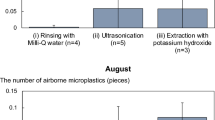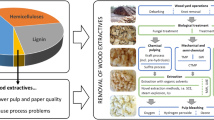Abstract
When pine wood decayed by white- and brown-rot fungi was observed in TEM after fixation and staining with glutaraldehyde/osmium tetroxide/ uranylacetate and embedding in Spurr’s ultralow viscosity resin electron dense particles, called “osmiophilic particles,” a typical distribution for the two decay types could be observed: in white-rotted wood the particles could be found in and around the hyphae and on the lumen surface of the wood cell wall, mostly aggregated to thick clusters. During the whole course of decay the wood cell walls were free of the particles, but they were present on the corroded surfaces. In brown-rotted wood the “osmiophilic particles” also could be found in and around the hyphae, but in contrast the particles were distributed over all the wood cell wall layers from the early to late stages of decay.
The distribution of the “osmiophilic particles” coincides with the place where the major cell wall degradation takes place: in white-rot the cell walls are degraded from the lumen to the middle lamella; in brown-rot a depolymerization and degradation of the carbohydrates takes place all over the wood cell wall. Since the “osmiophilic particles” can be found where the degradation takes place, it can be concluded that they are causally connected with wood decay.
The fact that they also were found in, and some of them also around, hyphae grown on malt-agar or Sabouraud-dextrose-agar proves that they are produced by the fungi and cannot be degradation products.
The possibility that they could be preparative artifacts can be excluded because uncolonized wood was free of “osmiophilic particles.”
Since the “osmiophilic particles” are produced by the fungi and can be found in places where wood is decaying, it can be further concluded that they are a fungal agent that is involved in wood degradation, probably fungal enzymes. The observation that the large “osmiophilic particles,” which may have a size of up to 20 nm, are composed of globular subunits of a diameter of 2—3 nm also speaks for their enzymatic nature.
To find out which type of enzyme they might be, the white-rot fungusTrametes hirsuta was grown on wood pulp with 7% lignin, on delignified wood pulp containing cellulose and hemicellulose, and on filterpaper (pure cellulose). The hyphae on wood pulp containing 7% lignin were surrounded by thick sheaths of “osmiophilic particles,” whereas with the hyphae grown on delignified wood pulp and pure cellulose only a few particles could be found. This makes it clear that the production of the “osmiophilic particles” is induced by lignin.
Similar content being viewed by others
References
Messner, K., and Stachelberger, H. (1984a),Trans. Br. Mycol. Soc. in press.
Messner, K., and Stachelberger, H. (1984b),Trans. Br. Mycol. Soc. in press.
Messner, K., Foisner, R., Stachelberger, H., Rohr, M. (1984),Trans. Br. Mycol. Soc. in press.
Author information
Authors and Affiliations
Rights and permissions
About this article
Cite this article
Messner, K., Stachelberger, H. “Osmiophilic particles”—a fungal agent with characteristic distribution in white-and brown-rotted wood. Appl Biochem Biotechnol 9, 391–392 (1984). https://doi.org/10.1007/BF02798991
Issue Date:
DOI: https://doi.org/10.1007/BF02798991




